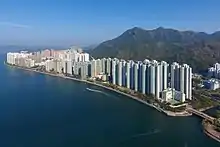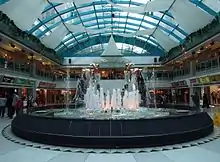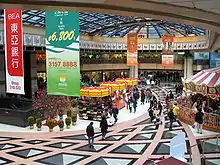Ma On Shan (town)
Ma On Shan is a new town along the eastern coast of Tolo Harbour in the New Territories of Hong Kong. Although it was initially an extension of Sha Tin New Town, it has its own town centre and various government facilities, and is now classified as a separate new town in government reports.[1] Administratively, it belongs to Sha Tin District.
| Ma On Shan | |||||||||||
|---|---|---|---|---|---|---|---|---|---|---|---|
 View of Ma On Shan and the Tolo Harbour. The namesake mountain is visible in the background. | |||||||||||
| Traditional Chinese | 馬鞍山 | ||||||||||
| Simplified Chinese | 马鞍山 | ||||||||||
| Literal meaning | Saddle Hill | ||||||||||
| |||||||||||
Geography
Ma On Shan is located by the west face of the twin peaks of Ma On Shan, which can be translated as "horse saddle mountain". The town is built on the strip between Tolo Harbour and Ma On Shan mountain. The north end of the town reaches the settlement of Wu Kai Sha and the southern Tai Shui Hang.
History
The original Ma On Shan Village still houses around 80 families. Yan Kwong Lutheran Church, one of two original churches established during the area's mining heyday, was revitalised in around 2014 as a centre to highlight the history and culture of the old village.[2]
Deep inside the slope of Ma On Shan was an iron mine. Due to the 1970s energy crisis and progressing New Town development, Ma On Shan Iron Mine was closed in 1976 from unprofitability.[3]
Three treasures
Historically, the three treasures of Ma On Shan were:
1. Iron ore: The deposit is estimated to have comprised over 7 million tonnes. The iron extracted from the 1950s to 1970s was mainly exported to Japan.
2. Azaleas: The azalea species Rhododendron hongkongense was discovered in Hong Kong in 1851 but was mistaken for another, only acquiring its "Hongkong" name in 1930. The species, which is found only on Ma On Shan and a few nearby sites, blooms in April with colours ranging from white to light red. Since 2006, an annual "Ma On Shan Azalea Festival" has promoted the azalea as the symbol of the district, celebrating six locally native species: (Rhododendron championae, Rhododendron farrerae, Rhododendron hongkongense, Rhododendron moulmainense, Rhododendron simiarum and Rhododendron simsii[4]) Various activities are held, including planting azaleas in housing estates and greenery areas, a photo-taking competition, painting competition, and exhibitions. The event is organised by Sha Tin East Area Committee of the District Council, Sha Tin District Office, Civil Engineering and Development Department, Leisure and Cultural Services Department, Ma On Shan Promotion of Livelihood and Recreation Association, the MTRC and various other bodies.[5][6]
3. Indian muntjac (Muntiacus muntjak): The natural habitat of this species includes Hong Kong and as far west as India, Pakistan and Afghanistan. The male has short antlers and canine teeth and likes to rest in bushes or tall grass. It feeds on leaves, underground roots and tubers, and sometimes tree bark. They live alone and if they are scared or during the mating season, produce a strange bark, hence their nickname "barking deer". They are timid and shy, with records showing that some local specimens died of fright when captured.
Development of public housing estates commenced in the mid-1980s, with Heng on Estate completed in 1987,[7] followed by Chevalier Garden in 1988.[8] The Ma On Shan line of the MTR was opened in 2004.[9]
Demographics
According to the 2016 by-Census, Ma On Shan has a population of 209,714, and 94% of the population is of Chinese ethnicity. Average household size is 3.1, and median monthly domestic household income is HK$ 33,000.[10]
Shopping centres



Whilst Ma On Shan is a relatively small town in the New Territories, it is well known by Hong Kong residents and expatriates alike. The town features a three-storey shopping centre, Sunshine City Plaza. Connecting to MOSTown are two other shopping centres; Ma On Shan Plaza and Sunshine Bazaar.
Ma On Shan Plaza
Ma On Shan Plaza is a shopping centre in the town centre of Ma On Shan in the Sha Tin District. Located on Sai Sha Road, it is connected to MOSTown and the Ma On Shan station of the MTR Tuen Ma line by footbridges. It is an associated shopping centre built together with the residential estate of Bayshore Towers, developed by Cheung Kong Holdings. The shopping centre has been famous for its indoor merry-go-round for the amusement of visitors who purchase items in any shops in the shopping arcade up to a certain amount. The merry-go-round, together with the water-operated clock tower next to it, has been the symbol of the Ma On Shan Plaza.
MOSTown
MOSTown is a one-stop place to buy almost anything. The majority of shops are clothing shops, including well-known labels like Levi's, Bauhaus, Adidas, Giordano, and many others mostly specialising in women's fashion. MOSTown also boasts a large "Citistore" department store selling clothes, mattresses, beds, toys, electrical appliances, luggage and more.
Numerous restaurants can be found in the plaza and as well as local Cantonese favourites, you will also find McDonald's and KFC outlets. A large "Market Place by Jasons" supermarket is present as is a pharmacy, cosmetics shops, hairdressers, tea houses, bakeries, shoe-shops and a classic favourite: an HK "$12" shop.
Sunshine Bazaar
Sunshine Bazaar is a small arcade-size retail space that features a bank, pet shop, music store, family medical centre and tutorial centre(s).
Private housing estates
Ma On Shan is an area with a high density of private housing estate. Some of the larger private housing estates in Ma On Shan are:
- Monte Vista – built by Hutchison Whampoa[11] in 2000, and consists of 1,606 residential units.[12]
- Sunshine City – constructed by Henderson Land Development in 5 phases during the 90's, contains more than 5000 residential units.
- Villa Athena[13] – built by Sun Hung Kai Properties Ltd. in 1994 and consists of 1,180 residential units
- Vista Paradiso – built by Hutchison Whampoa[14] in 1998,[15] and consists of 2,032 residential units.[16]
- Lake Silver
- Double Cove
Public facilities

The Ma On Shan Sports Ground opens all week. Badminton courts and table-tennis tables abound, and the cost of a badminton court for one hour is around HK$60 (half-price for students).
Near the sports centre is the Ma On Shan Public Swimming Pool. Adjacent to the pool is the 'SA Poolside Cafe', a popular café run by the Salvation Army, staffed by young disabled men and women who provide a valuable service and gain immensely from the experience. The majority of the café's profits go towards the Salvation Army.
The Ma On Shan Public Library, completed in 2005, is within walking distance from the sports centre and the swimming pool. The library provides an alternative location for reading and research to the Sha Tin Public Library.
Schools
- Renaissance College Hong Kong
- Hong Kong Taoist Association Shun Yeung Primary School
- Ma On Shan Ling Liang Primary School
- Tak Sun Secondary School
- Li Po Chun United World College
- Po Leung Kuk Chong Kee Ting Primary School
- ESF International Kindergarten, Wu Kai Sha
Public Transport

Trains
Ma On Shan is served by the Tuen Ma line of the MTR network. It was opened on 21 December 2004 by the Kowloon–Canton Railway. The last four stations on the line: Tai Shui Hang, Heng On, Ma On Shan, and Wu Kai Sha lie within Ma On Shan, with Ma On Shan station is located directly in the town centre. The rail line terminates at Kai Tak. Passengers can change at either Tai Wai to the East Rail line for service to Kowloon or the mainland border crossings at Lo Wu and Lok Ma Chau, or Diamond Hill to the Kwun Tong line for service to eastern Kowloon.
As part of the Sha Tin to Central Link project, the Ma On Shan line will be extended via Hin Tin and the Lion Rock Tunnel to eastern Kowloon and connect with the West Rail line at Hung Hom station, forming the Tuen Ma line with direct service to Tsuen Wan and Tuen Mun.
Buses
Numerous buses and public light buses serve the area and connect residents to nearby places including Sha Tin, Tai Po, and Kowloon, including a number of cross-harbour routes to Hong Kong Island. The city is served by several bus terminals, notably Ma On Shan Town Centre and Lee On Bus Terminus.
Taxis
Ma On Shan is served by both green and red taxis. Green taxis only serve the New Territories, while the pricier Red Taxis serve the urban areas of Hong Kong Island and Kowloon.
References
- (PDF) https://web.archive.org/web/20110721092543/http://www.statistics.gov.hk/publication/stat_report/population/B1220001012006XXXXB0202.pdf. Archived from the original (PDF) on 21 July 2011. Retrieved 2 March 2011. Missing or empty
|title=(help) - Kwok, Long-yin (26 September 2015). "Take a glimpse of Hong Kong's mining past". EJ Insight.
- "馬鞍山礦業發展簡史 - 鞍山歲月 - 馬鞍山民康促進會". mos.hk. Retrieved 21 April 2020.
- "Native Azaleas in Hong Kong" (PDF). Archived from the original (PDF) on 23 January 2007. Retrieved 26 September 2015.
- Ma On Shan Azalea Festival Archived 31 October 2011 at the Wayback Machine
- "Ma On Shan Azalea". Archived from the original on 31 October 2011.
- "Heng on Estate". Hong Kong Housing Authority. Government of Hong Kong. Retrieved 8 February 2011.
- "Chevalier Garden". Hong Kong Housing Authority. Government of Hong Kong. Retrieved 8 February 2011.
- "The Financial Secretary inaugurates MOS Rail today". Kowloon-Canton Railway Corporation. 21 December 2004. Archived from the original on 14 June 2011. Retrieved 7 August 2009.
- "District Profiles". 2016 Population By-census. Census and Statistics Department, Hong Kong Government. Retrieved 1 November 2020.
- Profile of Monte Vista
- Official website of Monte Vista Archived 7 February 2012 at the Wayback Machine
- Official website of Villa Athena
- Information page for Vista Paradiso
- Emporis.com
- Hong Kong Property
| Wikimedia Commons has media related to Ma On Shan. |
